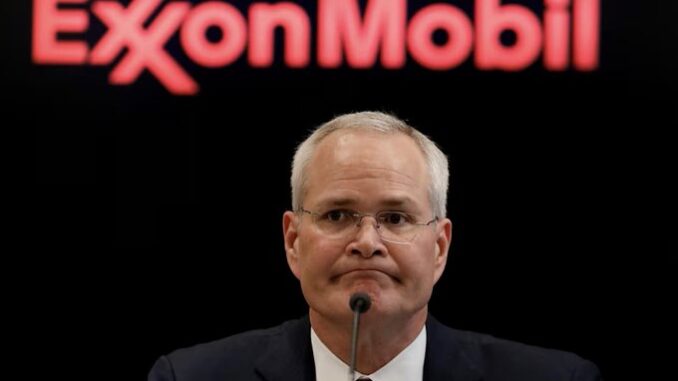
As global oil prices hover below $70 per barrel and competition intensifies, major oil companies are achieving a remarkable feat: record or near-record production levels while significantly reducing headcounts. This shift marks what industry insiders call the “survival efficiency” phase for Big Oil – a relentless focus on squeezing more barrels out of existing assets through digital tools, automation, and restructuring, even as capital spending tightens.
A recent post from commodity trader Jack Prandelli (@jackprandelli) captured the moment perfectly, highlighting ExxonMobil’s announcement of 2,000 global job cuts, a major organizational merger, and the closure of its Fife Ethylene Plant in Scotland by 2026. The goal? “Strip out layers, digitize operations, and defend margins with WTI under $60.” Prandelli noted that Chevron and BP are following suit – Chevron targeting billions in AI-driven savings, BP shedding staff and assets – transforming from “sprawling empires” into “lean, integrated, hyper-efficient machines.”
This trend extends across the industry. U.S. oil and gas employment has plummeted despite record production, with jobs down sharply in 2024-2025 due to automation, outsourcing, and cost discipline. Fewer rigs and workers now produce more oil than pre-pandemic levels, thanks to advances in AI, machine learning, and robotics.

How AI is Supercharging Efficiencies in Oil & Gas
Artificial intelligence is no longer a buzzword in upstream and downstream operations – it’s delivering tangible gains:
Predictive Maintenance & Drilling Optimization: AI analyzes sensor data to predict equipment failures, reducing downtime. ExxonMobil, BP, and Shell use AI for real-time drilling adjustments, shortening timelines and boosting recovery rates. Exxon has credited AI and analytics for a 4% production increase in recent years.
Reservoir Modeling & Seismic Interpretation: Machine learning processes vast datasets faster and more accurately than humans. BP’s “Sandy” AI platform cut seismic interpretation time by up to 90%. Chevron and ExxonMobil apply similar tools for subsurface modeling, maximizing output from fields like the Permian and Guyana.
Energy Optimization & Supply Chain: ExxonMobil uses AI to minimize refining energy use, while Chevron deploys AI-powered drones for inspections. Across the board, AI enables demand forecasting, route optimization, and leak detection, driving structural cost savings.
ExxonMobil CEO Darren Woods has emphasized AI’s “double effect of higher revenue and lower costs,” targeting $15 billion in savings by 2027 partly through digital tools. Chevron aims for $4 billion in AI-driven efficiencies, while ConocoPhillips integrates AI into its global wells data warehouse for scaled predictive models.

These gains allow companies to grow (or maintain) production in high-return basins like the Permian and Guyana without proportional increases in spending or staff.
Job Cuts at the Top Oil Companies: How Many Tied to AI?
While mergers (Exxon-Pioneer, Chevron-Hess, ConocoPhillips-Marathon) and low oil prices drive many reductions, AI and automation are explicit enablers of leaner operations. Direct attributions to “AI layoffs” are rare – companies cite “efficiencies,” “restructuring,” and “digital transformation” – but the link is clear in earnings calls and reports.
| Company | Announced Cuts (2024-2026) | Key Drivers & AI Role |
|---|---|---|
| ExxonMobil | ~2,000 global (2025-2026); additional post-Pioneer/Hess integrations | Digitization, organizational merger; AI for cost savings ($15B target by 2027) |
| Chevron | 15-20% global (~6,000-9,000); 575 in Houston post-Hess | Cost simplification, AI efficiencies ($4B target); Hess integration |
| ConocoPhillips | Up to 25% global (~3,000+) | Escalating costs, efficiency push; AI in data frameworks post-Marathon Oil merger |
| Shell | Ongoing structural reductions; exploration/downstream focus | $2-3B savings by 2025; AI in predictive maintenance and operations |
| BP | ~5% employees + contractors; further office cuts | $2B savings by 2026; AI in drilling and reservoir management |
Few cuts are solely blamed on AI – most stem from M&A synergies and broader cost discipline – but industry analyses (e.g., NYT, OilPrice.com) tie the 25%+ drop in sector jobs over the past decade to automation and digitalization.
The Irony: Big Oil Powers the AI Boom (And Wonders If It’s a Bubble)
As oil companies cut jobs for efficiency, they’re increasingly supplying the energy fueling AI’s explosive growth. Data centers could double U.S. electricity demand in coming years, with hyperscalers like Microsoft, Meta, and OpenAI building gigawatt-scale facilities.
ExxonMobil is in talks to develop gas-fired power plants for “decarbonized” data centers, leveraging its energy expertise. CEO Darren Woods sees a “huge advantage” here, positioning Exxon as a key enabler of AI infrastructure.
Yet skepticism abounds: Is the AI boom sustainable, or a bubble? Warnings are mounting in late 2025. Massive capex ($320B+ pledged for 2025 alone), debt-fueled data center builds, and energy constraints echo dot-com excesses. Harvard’s Jason Furman estimates data center spending drove nearly all U.S. GDP growth in H1 2025. Critics point to circular deals (e.g., Nvidia funding OpenAI data centers that buy Nvidia chips) and unproven profitability.
Nvidia’s earnings this week will be a litmus test – strong demand persists, but bubble fears grow if returns disappoint. If it bursts, demand for Big Oil’s natural gas could soften, easing pressure on grids but hitting revenues.
For now, the efficiency era marches on. Big Oil is proving it can produce more with less – delivering energy the world needs, including for the AI revolution, while adapting to a tougher margin environment. The question: How long can the lean machine run before the next disruption?








